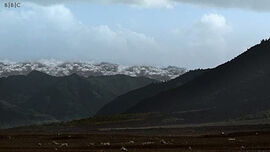| Mesozoic Era | |||||||
|---|---|---|---|---|---|---|---|

| |||||||
| Previous period Palaeozoic Era |
Following period Cenozoic Era | ||||||
The Mesozoic Era is one of three geologic eras of the Phanerozoic eon. The division of time into eras dates back to Giovanni Arduino, in the 18th century, although his original name for the era now called the "Mesozoic" was "Secondary" (making everything after, including the modern era, the "Tertiary"; the current term Quaternary was later proposed for the modern era, following the same numbering principle). Lying between the Paleozoic and the Cenozoic, "Mesozoic" means "middle animals", deriving from Greek prefix meso-/μεσο- for "between" and zoon/ζωον meaning "animal" or "living being". It is often called the "Age of the Reptiles", after the dominant fauna of the era.
The Mesozoic was a time of tectonic, climatic and evolutionary activity. The continents gradually shifted from a state of connectedness into their present configuration; the drifting provided for speciation and other important evolutionary developments. The climate was exceptionally warm throughout the period, also playing an important role in the evolution and diversification of new animal species. By the end of the era, the basis of modern life was in place.
Periods of the Mesozoic[]
| Image | Period Title | Time span |
|---|---|---|

|
Triassic | 251.9 to 201.3 MYA |

|
Jurassic | 201.3-145 MYA |
 |
Cretaceous | 145-66 MYA |
Geologic periods[]
Following the Paleozoic, the Mesozoic extended roughly 180 million years: from 251.9 MYA (Ma) to when the Cenozoic era began 66 Ma. This time frame is separated into three geologic periods. From oldest to youngest:
- Triassic (251.9 Ma to 201.3 Ma)
- Jurassic (201.3 Ma to 145 Ma)
- Cretaceous (145 Ma to 66 Ma)
The lower (Triassic) boundary is set by the Permian-Triassic extinction event, during which approximately 90% to 96% of marine species and 70% of terrestrial vertebrates became extinct. It is also known as the "Great Dying" because it is considered the largest mass extinction in the Earth's history. The upper (Cretaceous) boundary is set at the Cretaceous-Tertiary (KT) extinction event (now more accurately called the Cretaceous–Paleogene (or K–Pg) extinction event[1]), which may have been caused by the impactor that created Chicxulub Crater on the Yucatán Peninsula. Approximately 50% of all genera became extinct, including all of the non-avian dinosaurs.
Life[]
The extinction of nearly all animal species at the end of the Permian period allowed for the radiation of many new lifeforms. In particular, the extinction of the large herbivorous and carnivorous dinocephalia left those ecological niches empty. Some were filled by the surviving cynodonts and dicynodonts, the latter of which subsequently became extinct. Animal life during the Mesozoic was dominated, however, by large archosaurian reptiles that appeared a few million years after the Permian extinction: dinosaurs, pterosaurs, and aquatic reptiles such as ichthyosaurs, plesiosaurs, and mosasaurs.
The climatic changes of the late Jurassic and Cretaceous provided for further adaptive radiation. The Jurassic was the height of archosaur diversity, and the first birds and placental mammals also appeared. Angiosperms radiated sometime in the early Cretaceous, first in the tropics, but the even temperature gradient allowed them to spread toward the poles throughout the period. By the end of the Cretaceous, angiosperms dominated tree floras in many areas, although some evidence suggests that biomass was still dominated by cycad and ferns until after the KT extinction.
Some have argued that insects diversified with angiosperms because insect anatomy, especially the mouth parts, seems particularly well-suited for flowering plants. However, all major insect mouth parts preceded angiosperms and insect diversification actually slowed when they arrived, so their anatomy originally must have been suited for some other purpose.
As the temperatures in the seas increased, the larger animals of the early Mesozoic gradually began to disappear while smaller animals of all kinds, including lizards, snakes, and perhaps the ancestor mammals to primates, evolved. The KT extinction exacerbated this trend. The large archosaurs became extinct, while birds and mammals thrived, as they do today.
